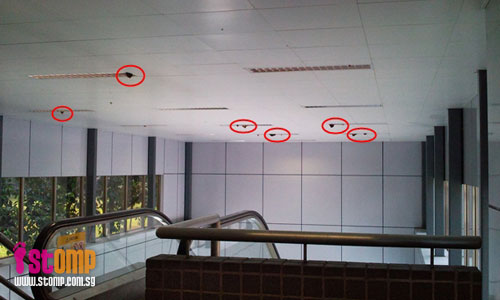
There are several beehives at the overhead bridge ceiling leading to SGH and STOMPer DMummy was shocked when she saw the number of the bees flying in the vicinity.
In her email to STOMP today (Feb 16), the STOMPer wrote:
"Yesterday I went to SGH to visit my relative. I used the overhead bridge at Outram MRT, which leads to SGH.
"When I went up the escalator, I got a shock, as there are bees flying everywhere!
"I looked up and was shocked to see numerous beehives on the lights.
"There was at least six or seven of bee hives on the ceiling lights.
"With the giant hives, directly above the escalator going up, those who have to use the overhead bridge, will definitely have to pass under the hives. This is so dangerous."


These aggregations of honeybees are not hives, but swarms.
This entry on Wikipedia is an excellent place to learn about swarming behaviour in honeybees. A couple of other sites that talk about bee swarms and how to cope with them can be accessed here and here.
Basically, swarming involves the colony splitting up, with a portion of the workers leaving the hive to follow one of the queens in establishing a new colony. In most cases, the original queen leaves, and a newly mated queen takes her place. This first swarm may soon be followed by other young queens setting out to start colonies of their own. While some scouts set out to explore new potential sites for hives, the swarm remains in one place, living off the reserves of nectar and honey which they consumed before they left the hive. It is said that swarming bees tend to be less aggressive since they do not have a hive to defend, although it definitely does not mean that one can disturb the swarm with impunity.
Singapore is home to 3 species of honeybee; the smallest and least aggressive species is the black dwarf honeybee (Apis andreniformis). The Asiatic honeybee (Apis cerana) is a close relative of the western honeybee (Apis mellifera) that forms the bulk of the global beekeeping industry. The third species, the giant honeybee (Apis dorsata), is the largest and most aggressive of our local honeybees. Without close-up photos of individual bees, it is impossible to tell which species is involved in this particular swarming episode.



The 3 honeybee species found in Singapore.
Left: Black dwarf honeybee (Apis andreniformis);
Middle: Asiatic honeybee(Apis cerana);
Right: Giant honeybee (Apis dorsata);
(Photo of Asiatic honeybee by budak, all other photos in this post are taken from vespa-bicolor.net)
Honeybees are part of the Hymenoptera, the group that encompasses the insects we colloquially know as wasps, bees and ants. Apart from the honeybees, Singapore has a great diversity of other bee and wasp species. These include a couple of carpenter bees (Xylocopa spp.), which can be very common and conspicuous in our gardens and parks, as well as various other solitary and social bee species.


Two species of carpenter bee commonly encountered in Singapore.
Left: Xylocopa confusa;
Right: Xylocopa latipes;
As for the social wasps, the most prominent are the hornets, of which at least 4 species are known to occur in Singapore, the lesser banded hornet (Vespa affinis), yellow-vented hornet (Vespa analis), greater banded hornet (Vespa tropica), and the rarely encountered Asian hornet (Vespa velutina), along with many other smaller wasp species, such as those of the genus Polistes.




Four hornet species known to occur in Singapore.
Upper left: Lesser banded hornet (Vespa affinis);
Upper right: Yellow-vented hornet (Vespa analis);
Lower left: Greater banded hornet (Vespa tropica);
Lower right: Asian hornet (Vespa velutina);



Three Polistes wasps that have been recorded in Singapore.
Left: Polistes sagittarius;
Middle: Polistes stigma;
Right: Polistes tenebricosus;
I have to admit, it's not easy living alongside insects that can give painful stings, or worse, sting en masse. I can understand why most people flinch the moment a bee or wasp gets too close for comfort. On two separate occasions, I've had my classes disrupted when a solitary hornet flew into the classroom, sending a whole bunch of students ducking for cover. When these insects build their colonies too close to where we live, work and play, posing a risk to our health, it is necessary to take action. Yet at the same time, the indispensable roles that bees and wasps play in our ecosystem cannot be overlooked. Many plants depend heavily on bees and wasps to pollinate their flowers, whereas various wasps are significant predators or parasites of other insects. Perhaps it is necessary for people to look beyond the stingers, and learn how to best coexist with these social insects.